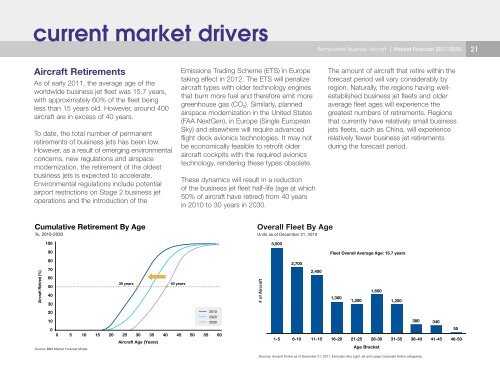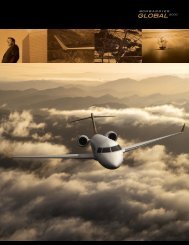Bombardier Business Aircraft | Market Forecast 2011-2030 - Learjet ...
Bombardier Business Aircraft | Market Forecast 2011-2030 - Learjet ...
Bombardier Business Aircraft | Market Forecast 2011-2030 - Learjet ...
Create successful ePaper yourself
Turn your PDF publications into a flip-book with our unique Google optimized e-Paper software.
current market drivers<br />
<strong>Aircraft</strong> Retirements<br />
As of early <strong>2011</strong>, the average age of the<br />
worldwide business jet fleet was 15.7 years,<br />
with approximately 60% of the fleet being<br />
less than 15 years old. However, around 400<br />
aircraft are in excess of 40 years.<br />
To date, the total number of permanent<br />
retirements of business jets has been low.<br />
However, as a result of emerging environmental<br />
concerns, new regulations and airspace<br />
modernization, the retirement of the oldest<br />
business jets is expected to accelerate.<br />
Environmental regulations include potential<br />
airport restrictions on Stage 2 business jet<br />
operations and the introduction of the<br />
Cumulative Retirement By Age<br />
%, 2010-<strong>2030</strong><br />
<strong>Aircraft</strong> Retired (%)<br />
100<br />
90<br />
80<br />
70<br />
60<br />
50<br />
40<br />
30<br />
20<br />
10<br />
0<br />
0<br />
Source: BBA <strong>Market</strong> <strong>Forecast</strong> Model.<br />
5<br />
10<br />
15<br />
20<br />
30 years<br />
25<br />
30<br />
35<br />
<strong>Aircraft</strong> Age (Years)<br />
40<br />
40 years<br />
45<br />
Emissions Trading Scheme (ETS) in Europe<br />
taking effect in 2012. The ETS will penalize<br />
aircraft types with older technology engines<br />
that burn more fuel and therefore emit more<br />
greenhouse gas (CO 2). Similarly, planned<br />
airspace modernization in the United States<br />
(FAA NextGen), in Europe (Single European<br />
Sky) and elsewhere will require advanced<br />
flight deck avionics technologies. It may not<br />
be economically feasible to retrofit older<br />
aircraft cockpits with the required avionics<br />
technology, rendering these types obsolete.<br />
These dynamics will result in a reduction<br />
of the business jet fleet half-life (age at which<br />
50% of aircraft have retired) from 40 years<br />
in 2010 to 30 years in <strong>2030</strong>.<br />
50<br />
55<br />
2010<br />
2020<br />
<strong>2030</strong><br />
60<br />
Overall Fleet By Age<br />
Units as of December 31, 2010<br />
# of <strong>Aircraft</strong><br />
3,500<br />
1-5<br />
2,700<br />
6-10<br />
2,400<br />
11-15<br />
<strong>Bombardier</strong> <strong>Business</strong> <strong>Aircraft</strong> | <strong>Market</strong> <strong>Forecast</strong> <strong>2011</strong>-<strong>2030</strong> 21<br />
The amount of aircraft that retire within the<br />
forecast period will vary considerably by<br />
region. Naturally, the regions having wellestablished<br />
business jet fleets and older<br />
average fleet ages will experience the<br />
greatest numbers of retirements. Regions<br />
that currently have relatively small business<br />
jets fleets, such as China, will experience<br />
relatively fewer business jet retirements<br />
during the forecast period.<br />
Fleet Overall Average Age: 15.7 years<br />
1,300<br />
16-20<br />
1,200<br />
21-25<br />
1,600<br />
26-30<br />
Age Bracket<br />
1,200<br />
31-35<br />
380<br />
36-40<br />
Sources: Ascend Online as of December 31, <strong>2011</strong>. Excludes Very Light Jet and Large Corporate Airline categories.<br />
340<br />
41-45<br />
55<br />
46-50



